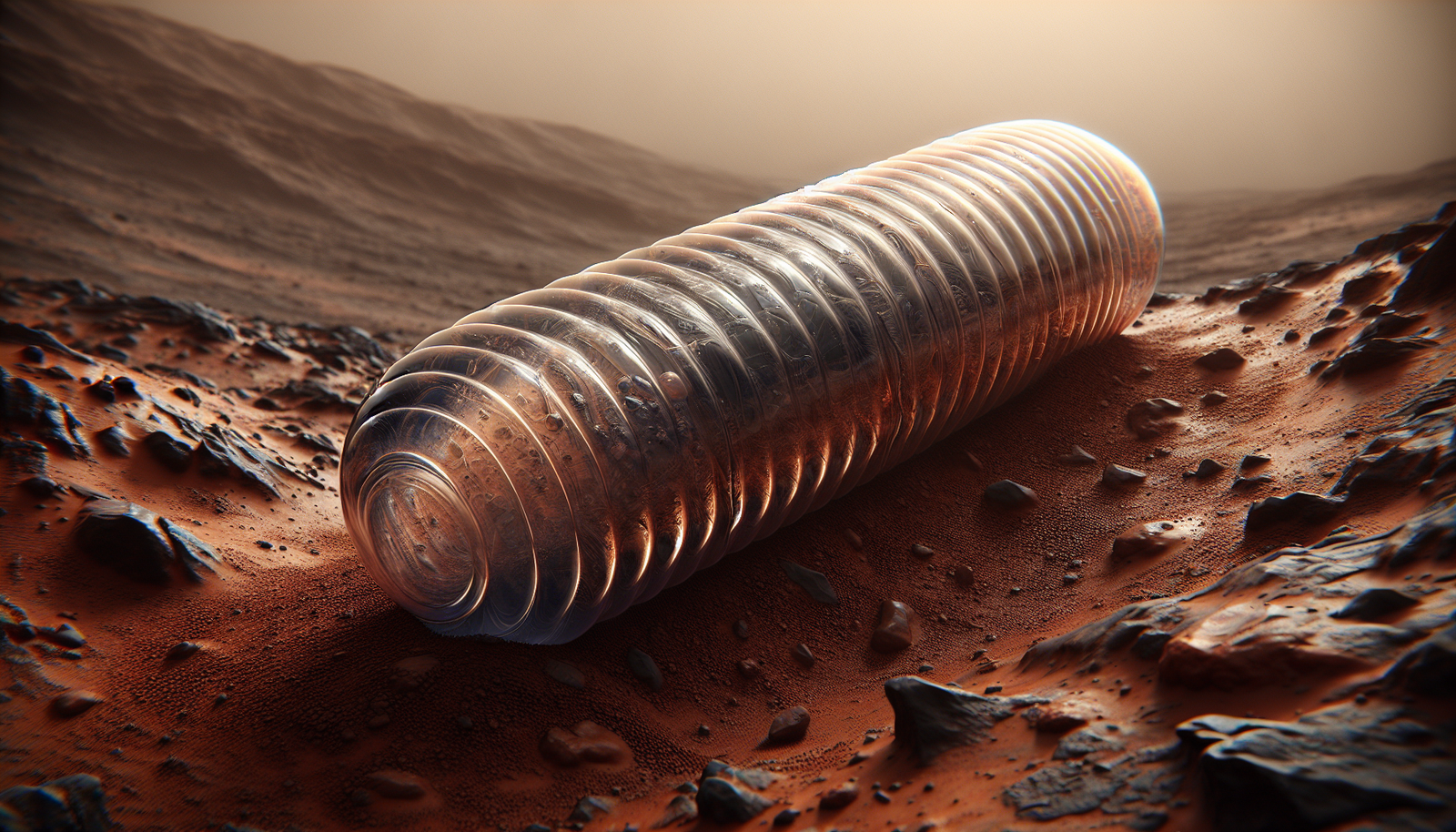Exploring Mars Anomalies: Unexplained Discoveries

By Amara Okafor, Ufologist
Introduction: Mars - A World of Intrigue and Mystery
Mars. Just the name conjures images of a rust-colored landscape, vast canyons, and towering volcanoes. For centuries, we humans have gazed at this crimson point of light in the night sky, sensing something profoundly different about it, something special. It's a planetary sibling, the most Earth-like world in our solar system, scarred with geological features that whisper of a past starkly different from its current cold, arid state – features like dry riverbeds and polar ice caps that make you wonder what stories those rocks could tell if only they could speak.
Our journey to understand Mars has been a fascinating unfolding of discovery, transforming it from a distant speculation into a world under intense scrutiny. It began with fleeting glimpses from missions like Mariner 4 back in the 1960s, providing the first close-up, slightly blurry hints of its surface. Fast forward to today, and we're practically bombarded with data. A fleet of sophisticated orbiters like the Mars Reconnaissance Orbiter (MRO), Mars Express, and the Mars Global Surveyor relentlessly map its surface, while robotic explorers like Spirit, Opportunity, Curiosity, and Perseverance inch across its terrain, sending back breathtaking vistas and incredibly detailed information. With this explosion of data, the inventory of "Mars Anomalies" has grown exponentially.
So, what exactly do we mean by "Mars Anomalies"? In essence, they are observations – be it a peculiar rock formation, an unexpected data reading from an instrument, or a strange atmospheric event – that don't quite fit the script. They resist immediate, straightforward explanation based on what we currently know about Martian geology, its thin atmosphere, or its long, complex history. These anomalies exist on a spectrum. Some are visual quirks, easily dismissed once you look closer, while others represent genuinely baffling scientific puzzles that have researchers scratching their heads.
Before we go further, it's crucial to address a powerful filter through which we often view these images: our own minds. We humans are pattern-seeking creatures. Our brains are wired to find familiar shapes, especially faces, in random arrangements. This phenomenon, known as pareidolia, is responsible for countless "sightings" in clouds, toast, and yes, Martian rocks. The most celebrated example is the "Face on Mars." Captured by the Viking 1 orbiter in 1976, an image showed a mesa in the Cydonia region that, under specific lighting and from a distance, bore an uncanny resemblance to a human face. It fueled decades of speculation about ancient alien monuments. However, when the Mars Global Surveyor captured higher-resolution images in 2001, the "face" resolved into what it truly was: a natural hill shaped by eons of wind and erosion. It's a classic case study in how perception and expectation can shape interpretation.
But – and this is a critical point – not every Martian oddity can be neatly filed away under "pareidolia." The steady stream of data, particularly from instruments designed to probe beneath the surface like those on the InSight lander, is bringing forth perplexing signals and structures that have nothing to do with seeing faces in rocks. There are whispers from the deep interior, strange happenings in the thin air, and chemical signatures that hint at processes we don't fully understand. Mars, it seems, still holds profound secrets. Our purpose here is to explore some of the most compelling of these anomalies, looking at the evidence, considering the scientific explanations, and acknowledging the questions that still linger, painting a picture of Mars as the complex, scientifically captivating, and profoundly mysterious world it truly is.
Anomalies on the Surface: Where Rocks Tell Peculiar Stories
The ground truth of Mars comes largely through the "eyes" of our robotic emissaries. Rovers like Curiosity and Perseverance, armed with sophisticated camera suites like Mastcam, Navcams, and the advanced Mastcam-Z, are our primary sources for visual anomalies. Curiosity alone has beamed back tens of thousands of images since its arrival in 2012. Imagine the sheer volume of rock, sand, and sky captured – it's practically inevitable that some formations will appear unusual, provocative, or downright strange.
Geometric and Potentially "Manufactured" Objects
One category that consistently sparks debate involves objects appearing geometric or somehow "manufactured." Take, for instance, an image captured by Curiosity on Sol 1448. It shows a relatively small object, partially buried, exhibiting remarkably defined corners and straight lines. Finds like this immediately ignite speculation about artificial origins – remnants of structures, tools, or deliberately carved objects. From a materials science perspective, such regular geometries are often indicative of crystalline structures or specific fracture patterns, but the visual impact can be undeniably suggestive of something non-natural. While geological processes like wind erosion (creating ventifacts) or the deposition of minerals can certainly produce angular shapes, the frequency with which these "geometric" objects appear in rover imagery keeps the alternative interpretations simmering. It's not just one odd rock; it's a recurring theme in the Martian landscape photos that prompts continued investigation.
Formations Resembling Life Forms or Fossils
Then there are the formations that play tricks on our biological pattern recognition, looking uncannily like life forms or their remains. The "Martian 'Finger'" snapped by Curiosity is a prime example – a rock projection that, from the camera's angle, strikingly resembles a digit complete with what looks like a fingernail. Similarly, the "‘Rodent’ On Mars Picture" captures a rock formation that, viewed just so, brings to mind a small mammal, perhaps a guinea pig. While pareidolia is almost certainly the culprit here, the strength of the resemblance is what makes these images captivating. Another curious example is the "Mars Seashell" anomaly, seen in images from the older Spirit rover. These objects display a spiraling structure very similar to terrestrial seashells. Are they just unusually weathered rocks, or could they be fossilized remnants of a very different Martian past? Some researchers have even claimed to see insect-like forms in rover images, though these are often based on grainy, low-detail pictures where pareidolia can run rampant.
Large-Scale Structures and Features
Beyond these smaller curiosities are larger, more complex features that some interpret as evidence of ancient, large-scale construction. The "Mars Port," described as a highly geometric, two-story structure on a cliffside, complete with a circular area resembling a landing pad, certainly challenges conventional geological explanations based on the description alone. Then there's the alleged "Mars Tower," a structure some anomaly hunters claim stands an incredible 6.3 kilometers tall – vastly exceeding any structure on Earth. The "Star City on Mars," located within the Syrtis Major Planum, is noted for its complex patterns and what some see as artificial walls. The Cydonia region, home to the famous (and now largely debunked) "Face," also hosts the "Martian Pyramids." These features, with their relatively smooth, triangular faces, bear a noticeable resemblance to aerial views of Egypt's Giza pyramids. While the scientific consensus attributes these large formations to natural geology – massive mesas, eroded mountains, complex dune fields – their scale and perceived geometric regularity continue to fuel speculation about a non-natural origin.
Orbital Phenomena
Shifting our gaze upward, orbiters have captured phenomena on a grander scale that also present puzzles. The "Martian Trees and Shrubs" are a fascinating case. These dark spots, observed on sand dunes in the southern polar region, appear to grow and darken with the Martian spring, coinciding with increased warmth and sunlight. A Hungarian research team has controversially proposed that these are biological, representing the life cycle of some form of Martian vegetation. NASA, however, maintains that these features are a result of seasonal defrosting processes, where sublimating carbon dioxide ice dislodges dark dust. Without landing nearby and taking samples, this debate remains unresolved. Another orbital mystery are the "Glass Tubes" or "Glass Worms." These long, ribbed, sometimes translucent structures have been captured in various images. NASA's official explanation often points to them being "dune trains," linear formations of sand dunes. However, critics point out significant visual differences between these tubes and known dune formations. Their scale and peculiar appearance, especially the reported translucence in some cases, make them a persistent point of discussion. While many striking patterns seen from orbit, like the beautiful lava coils or the intricate "spiders" near the South Pole (now understood to be carved by erupting CO2 gas), have convincing geological explanations, Mars continues to show us surface features that defy easy categorization. Think of the "Valley of the Boulders," a scattering of large, dark rocks on a flat plain with no obvious source, or uniquely colored formations like the whitish "Atoko Point" – these serve as reminders that Mars still has topographical stories we are only beginning to decipher, involving ancient impacts, volcanic ejecta, and vast water flows that could transport materials across the planet.
Anomalies Beneath the Surface: Whispers from the Martian Interior
For much of our exploration history, Mars' secrets seemed confined to its surface. But the arrival of NASA's InSight lander in 2018 marked a profound shift, equipping us with the tools – primarily a highly sensitive seismometer (SEIS) and the Rotation and Interior Structure Experiment (RISE) – to listen to the planet's heartbeat and probe its hidden depths. What InSight revealed has moved the discussion of Martian anomalies into a new, subsurface dimension.
Gravity Anomalies and Buried Structures
One of the most striking findings comes from gravity measurements. By meticulously analyzing subtle variations in Mars' gravitational pull, detected by InSight and orbiting satellites, scientists constructed a global density map. This map revealed the presence of roughly twenty unexpected, massive structures buried deep beneath the northern plains. These aren't mountains or canyons, but enormous blobs of material significantly denser (by about 300-400 kg/m³) than the surrounding rock. Invisible from the surface, they lie hidden under thick layers of sediment, possibly remnants of an ancient northern ocean. Their origin remains a puzzle: are they the incredibly dense cores of ancient, buried volcanoes? Compacted rubble from colossal asteroid impacts billions of years ago? Or something else entirely? One of these anomalies even presents a shape whimsically described as resembling a dog, a curious coincidence perhaps, but indicative of the varied forms these hidden masses take. Their existence points to a complex geological history we are only starting to access.
Seismic Strangeness
InSight's primary mission was to listen for "marsquakes," and it detected over 1,300 of them. While many conform to expected patterns of tectonic stress release or cooling contraction, some seismic signals were decidedly odd. Take the reported "banging sounds underground." These weren't the typical rumbles of a quake, but repetitive, sharp, almost metallic triplets of pulses, consistently originating from beneath the Elysium Planitia region. NASA's explanation leans towards subsurface rock fracturing, but the rhythmic, patterned nature of the sounds fuels speculation about less conventional sources, perhaps echoes in a large void or even pulsed energy releases.
Even more bizarre was the "soundless quake" detected in late 2023. A powerful magnitude 4.1 event, one of the strongest recorded, registered on the seismometer but generated no discernible acoustic waves. Quakes of this magnitude on Earth are noisy events, even deep underground. This Martian silence is deeply perplexing. Could it be a type of fault slip that somehow avoids vibrating the surrounding rock? Or does it point to a type of subsurface movement that doesn't involve displacing mass in the conventional way? Some have even controversially suggested phenomena like tunneling. Adding to the seismic strangeness is the "seismic echo loop." Analysis of some quake data revealed echoes that didn't just fade away; they returned delayed, distorted, and unexpectedly *stronger*, repeating as if bounced off something unnaturally smooth or potentially hollow. While extensive subsurface ice sheets could potentially cause unusual reflections, some echo events lacked a clear geological explanation, prompting hypotheses about vast underground caverns or chambers. Furthermore, quakes originating from regions like Cerberus Fossae and the immense Valles Marineris canyon system suggest these areas might still possess geological activity, challenging the view of Mars as a completely dormant world.
Thermal Anomalies
Beyond seismic waves, InSight provided intriguing thermal data. The heat probe, nicknamed "the mole," encountered difficulties drilling but left behind a mystery: a faint, cylindrical heat signature detected beneath the landing site *before* the mole's deployment seemingly vanished *after* the probe was removed. What was this localized heat source? Was it a pocket of geothermal warmth, or something else disturbed by the drilling attempt? Later, in 2024, InSight's temperature sensors recorded a "deep thermal pulse" – a rapid, localized spike in heat rising from within the crust, then quickly dissipating, without any accompanying seismic activity. These findings don't align neatly with standard volcanic models, leaving scientists questioning the source – residual core heat, unknown chemical reactions, or perhaps even localized energy release.
Crustal Structure and Movement
The lander itself revealed subtle clues. A tiny, almost imperceptible "sudden tilt" was recorded, not caused by wind or temperature changes, but by a gentle, internal shifting of the ground beneath it. This hints that the Martian crust might be more dynamic than assumed, or perhaps that large-scale, slow movements are occurring deep underground. Seismic analysis also pointed to a "layer that shouldn't exist" – a disrupted, irregular zone at the boundary between the crust and mantle. Located in a quadrant aligned with strong quake clusters and thermal anomalies, this "broken shell" or "collapsed vault" scatters seismic waves in strange ways, suggesting a region fundamentally different from its surroundings – perhaps containing trapped gases, pockets of melt, or even vast empty spaces. These whispers from below paint a picture of a Martian interior far more active and structurally peculiar than we ever imagined.
Atmospheric Anomalies: Unexplained Phenomena in the Martian Air
Mars today possesses a wispy atmosphere, less than 1% the density of Earth's. It's a harsh environment, bombarded by solar radiation, and seemingly straightforward. Yet, even this thin envelope holds its share of puzzles, phenomena that stretch our understanding of atmospheric dynamics on the Red Planet.
High-Altitude Plumes
One of the more visual atmospheric head-scratchers occurred back in 2012. Amateur astronomers, and later verified observations including those potentially involving the Hubble Space Telescope, spotted enormous, transient plume-like features extending incredibly high into the Martian sky – over 155 miles (250 km) above the surface. This altitude is essentially the edge of space for Mars, a region where the atmosphere is exceedingly tenuous. How could such massive hazes form and persist there? Initial theories proposed extremely high-altitude clouds composed of water-ice or carbon dioxide crystals, or perhaps unusually bright and extensive auroral displays (similar to Earth's Northern and Southern Lights, but generated differently on Mars due to its lack of a global magnetic field). However, explaining the mechanism needed to loft material or energize particles to create such phenomena at those heights remains a significant challenge to atmospheric models. These weren't typical clouds or known auroras; they were something unexpected.
The Methane Mystery
Perhaps the most persistent atmospheric anomaly is the "methane mystery." Methane (CH4) is a relatively simple organic molecule, but its presence in the Martian atmosphere is deeply intriguing. Rovers like Curiosity have detected low levels of methane, but with perplexing variations. The gas appears sporadically, with concentrations sometimes spiking significantly before fading away again. This is puzzling because methane is chemically fragile in the Martian environment; ultraviolet radiation from the sun should break it down within a few centuries. Its continued presence, therefore, implies an active, ongoing source.
What could be producing it? The debate sharply divides between geology and biology. Geological processes, such as serpentinization – a reaction where water interacts with certain types of rock (like olivine, common on Mars) – can release methane. Trapped pockets of ancient methane released through cracks or seismic activity are another possibility. Indeed, some studies have noted a potential correlation between observed methane spikes and detected marsquakes, lending credence to the idea of subsurface geological releases.
However, on Earth, the vast majority of atmospheric methane is produced by living organisms, specifically microbes called methanogens. This inevitably raises the tantalizing possibility that the methane detected on Mars could be a biosignature – evidence of currently existing, subsurface microbial life. The observed seasonal pattern of methane concentrations, peaking in the late Martian summer in Gale Crater, further complicates purely geological explanations and keeps the biological hypothesis firmly on the table. Unfortunately, the Perseverance rover lacks a dedicated methane detector, although its mission to collect samples for eventual return to Earth might one day provide rock and soil cores containing trapped gases or minerals that could shed light on the methane's origin. For now, it remains one of Mars' most compelling and potentially profound anomalies.
Echoes of a Different Past: Anomalies Hinting at Habitability
Many Martian anomalies aren't just present-day quirks; they serve as powerful echoes, resonating from a time when Mars might have been a very different place – potentially a warmer, wetter world capable of supporting life. The stark contrast between Mars' current desiccated state and the mounting evidence of its watery past is, in itself, an awe-inspiring anomaly.
Evidence of Past Surface Water
The geological evidence for past surface water is now overwhelming. We see vast, dried-up riverbeds longer and wider than the Amazon, intricate delta fans like the one Perseverance is currently exploring in Jezero Crater, and ancient lakebeds stretching for hundreds of miles. Minerals discovered by rovers provide chemical proof: hematite "blueberries" found by Opportunity, which form in water; hydrated sulfates; clays; and peculiar "boxwork" mineral deposits, similar to formations found in Earth caves that require water saturation to form. These features tell a clear story: water once flowed freely and pooled extensively on the Martian surface.
Anomalies in Martian Meteorites
But the timeline of this watery past keeps getting pushed. Traditionally, scientists believed Mars dried up significantly around 3.5 billion years ago. Yet, anomalies found within Martian meteorites – rocks blasted off Mars by impacts and later landing on Earth – suggest a more extended aquatic history. The Lafayette meteorite, for instance, contains minerals like iddingsite that show signs of alteration by liquid water as recently as 740 million years ago! This dramatically later date implies that liquid water, perhaps from melting subsurface ice triggered by volcanic activity, could have existed long after the planet was thought to have become largely inactive and dry.
Going even further back, the famous "Black Beauty" meteorite (NWA 7034) provided a stunning glimpse into Mars' infancy. Within this ancient rock, scientists found tiny zircon crystals dating back 4.4 to 4.45 billion years – formed just after Mars itself coalesced. These crystals bear unmistakable chemical signatures indicating they formed in the presence of warm, or even hot, water. This pushes the potential for liquid water, and thus habitable conditions, right back to the very beginning of Martian history. It conjures images of early Mars potentially hosting hydrothermal vents, perhaps deep within ancient oceans – environments considered prime candidates for the origin of life on Earth.
Subsurface Water and Atmosphere Reservoirs
If Mars was once so wet, where did all the water go? And what happened to the thicker atmosphere needed to keep that water liquid? These questions lead to another set of profound anomalies linked to Mars' interior. Some recent studies, analyzing seismic data collected by InSight, have detected signatures beneath the surface that strongly resemble those associated with underground aquifers on Earth. The data suggests vast quantities of water might still exist deep underground, perhaps locked within fractured igneous rocks 11 to 20 kilometers below the surface. It's a staggering thought – Mars' missing oceans might not have escaped entirely to space, but could be largely trapped within the planet itself.
A similar hypothesis exists for the atmosphere. Models suggest that Mars once had a much denser carbon dioxide atmosphere. Where did it go? One compelling idea is that billions of years ago, vast amounts of CO2 reacted with Martian rocks and water, becoming locked away in carbonate minerals or clays (like smectites) beneath the surface. Some of this trapped carbon might have even been converted into methane by geological or biological processes, potentially contributing to the methane anomalies we see today. If these ideas hold true, Mars might possess enormous subsurface reservoirs of both water and the essential elements of its ancient atmosphere. This dramatically shifts our perspective on Martian habitability, suggesting that potential niches for life might persist deep underground, shielded from the harsh radiation and cold of the surface.
Remnants of a Magnetic Field
Finally, the scattered patches of magnetized crust, detected by orbiters, are anomalies left over from a time when Mars possessed a global magnetic field, much like Earth's. This field would have been crucial for shielding the early atmosphere and surface water from being stripped away by the solar wind. Analysis of Martian meteorites suggests this protective shield might have persisted longer than previously thought, perhaps until around 3.9 billion years ago. The existence and subsequent disappearance of this magnetic field are key events tied intimately to Mars' transition from a potentially habitable world to the challenging environment we see today. These magnetic remnants are fossils of a capacity for habitability that Mars once held.
The Human Perception Factor and Alternative Interpretations
It's impossible to discuss Mars anomalies without acknowledging the powerful role of human perception. As we saw with the "Face on Mars," our brains are incredibly adept at finding familiar patterns, even when they aren't really there. This tendency, pareidolia, accounts for a significant portion of the "weird objects" reported from rover images. Consider the "Human Thigh Bone" spotted by Curiosity in 2014 – a rock whose shape, coloration, and joint-like ends immediately evoke a limb bone, though it's almost certainly a product of wind or water erosion. Or the small, spherical concretions some called "Cannonballs," later identified as hematite pebbles. The "Martian 'Rodent'," the spooky "Skull Hill" formation named for its cavity-like depressions resembling eye sockets, or the various rocks likened to statues, spoons, or even vacuum cleaner attachments – these are potent examples of how random shapes, combined with suggestive lighting and shadow, can trick our eyes and ignite our imaginations.
Challenges in Image Interpretation
Image interpretation itself presents challenges beyond pareidolia. The way sunlight falls across the landscape can create dramatic shadows that mimic structures or openings, like the infamous "Alien Doorway" which turned out to be a small, naturally formed crevice. The angle from which an image is taken can distort perspective. And the images themselves aren't always perfect representations. Especially with older data, or images transmitted across vast distances, compression artifacts can introduce textures or blockiness that might be misinterpreted. Color filters applied by NASA for scientific purposes, or removed by enthusiasts analyzing raw data, can also alter the appearance of features. What looks like metal might just be a particular type of rock reflecting sunlight sharply. It takes careful scientific analysis, often involving multiple images, spectral data, and 3D modeling, to truly understand what we're seeing.
Alternative Narratives and Speculation
This inherent ambiguity, coupled with the profound human desire to find something extraordinary, has given rise to alternative interpretations that exist outside the scientific mainstream. Websites and communities dedicated to "Mars Anomaly Research" actively promote the idea that many of these peculiar features are not natural but are evidence of past or even present alien life, advanced civilizations, and potentially, a cover-up by space agencies like NASA and ESA. Proponents point to the geometric shapes, the seemingly artificial structures, the "glass tubes," and other oddities as proof that we are not being told the full story. They might argue that the sheer number and variety of anomalies defy coincidence or purely geological explanation. While fascinating, these claims generally lack rigorous scientific evidence and often rely on subjective interpretations of ambiguous images, ignoring Occam's razor – the principle that the simplest explanation is usually the best. There's no credible scientific indication of NASA or ESA deliberately hiding evidence; indeed, the discovery of life on Mars would likely be the biggest scientific news story in human history, something most scientists would be thrilled to announce. Yet, the persistence of these alternative narratives highlights the deep cultural resonance of Mars as a place of mystery and potential discovery, a cosmic canvas onto which we project our hopes and fears about life beyond Earth.
The Path Forward: Continued Exploration and the Search for Answers
The study of Mars anomalies isn't just about cataloging strange photos or puzzling data points; it's an integral part of the broader scientific endeavor to understand the Red Planet. Each unexplained observation serves as a question mark, pushing us to refine our models, develop new hypotheses, and ultimately, explore further. The path forward involves a multi-pronged approach, leveraging cutting-edge technology and building upon decades of previous exploration.
Ongoing Missions and Sample Return
Ongoing missions like NASA's Perseverance rover and various orbiters continue to gather unprecedented amounts of data. Perseverance, operating in Jezero Crater – a location specifically chosen for its high potential for past habitability due to its ancient lake and river delta – is equipped with instruments designed not only to analyze rocks and soil in situ but also to cache promising samples for a future, ambitious Mars Sample Return mission. Bringing Martian materials back to Earth labs for detailed analysis is seen by many as the best hope for definitively answering questions about past life and clarifying the nature of many geological and mineralogical anomalies.
Technological Advancements and Data Analysis
Technology plays a crucial role. Each successive generation of Mars spacecraft carries more sophisticated instruments: higher-resolution cameras capable of capturing finer details, advanced spectrometers to determine chemical and mineral composition with greater accuracy, ground-penetrating radar to peer beneath the sands, and more sensitive seismometers like InSight's to listen to the planet's inner workings. Furthermore, the sheer volume of data necessitates new approaches. Artificial intelligence and machine learning are increasingly being employed to sift through massive datasets, searching for patterns and anomalies that might escape human notice. Projects specifically focused on "Anomaly Detection on Mars Using Deep Learning" aim to systematically search for potential "technosignatures" – evidence of past or present extraterrestrial technology – moving beyond simple visual pattern recognition.
Influencing Future Exploration
Observed anomalies also directly influence mission planning. A strange feature spotted from orbit might become a target waypoint for a rover traverse. An area exhibiting unusual seismic activity or methane plumes could be prioritized for future landing sites equipped with specialized instruments. The goal is to move from remote observation to close-up investigation, turning puzzling anomalies into understood phenomena.
Collaboration and Open Data
International collaboration and the open sharing of data are also vital. Raw images and data from missions like Curiosity are often made publicly available, allowing independent researchers and citizen scientists worldwide to participate in the discovery process (though again, interpretation requires scientific rigor). This collective effort broadens the scope of analysis and brings diverse perspectives to bear on Martian mysteries.
The Ongoing Quest
Ultimately, unraveling the secrets behind Mars anomalies is a step-by-step process. Some mysteries, like the "Face on Mars" or the polar "spiders," yield to further observation and better understanding of Martian processes. Others, like the subsurface dense structures or the persistent methane spikes, remain active areas of research, demanding more data and innovative thinking. Each anomaly, whether eventually explained as a natural phenomenon or hinting at something more profound, serves as a valuable signpost, guiding our exploration and deepening our appreciation for the complex, dynamic, and utterly fascinating history of our neighboring world. The journey to fully understand Mars is far from over, and its anomalies promise many more surprises ahead.
From Bigfoot to UFOs: Hangar 1 Publishing Has You Covered!
Explore Untold Stories: Venture into the world of UFOs, cryptids, Bigfoot, and beyond. Every story is a journey into the extraordinary.
Immersive Book Technology: Experience real videos, sights, and sounds within our books. Its not just reading; its an adventure.


























